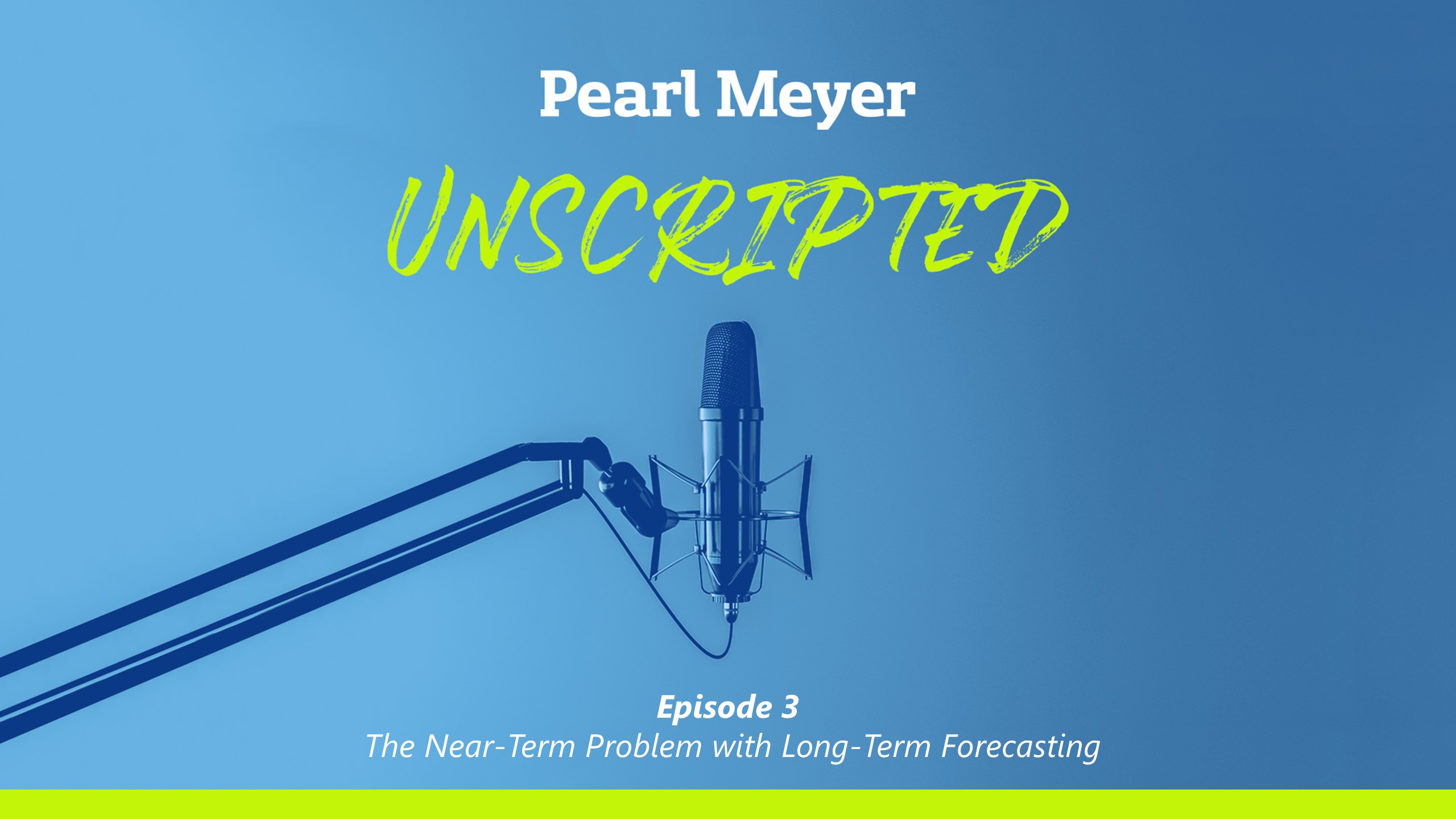
Podcast | Jun 2025 | The Pearl Meyer Unscripted Podcast
The Near-Term Problem with Long-Term Forecasting
S1 Ep3: The pros and cons of several creative ideas that can take the sting out of current long-term incentive plan design challenges.
Transcript
Jake: Is it really possible to get creative with long-term incentives? Thanks for joining us. I'm Jake George, CMO at Pearl Meyer, bringing you another illuminating discussion between two of our managing directors, Alap Shah and Mark Rosen. There's no doubt that companies are finding it difficult to forecast three years ahead. With most LTI plans constructed around a three-year timeframe, Mark and Aalap propose some interesting ideas for meaningful goal setting in the context of ongoing market upheaval.
Mark: Hey Aalap, I got another one for you. Do you have a few minutes to discuss another client situation?
Aalap: For you, Mark, always.
Mark: This is something I've dealt with a bunch of times and I continually try and get better ideas to solve this, but in this case, the doesn't really have a lot of confidence in their ability to forecast three years of financial performance. And with what's going on today, I don't blame them. They're currently losing EBITDA and ROIC. Any thoughts? Again, it's a three-year financial performance period.
Aalap: Yeah, I think it's a very common problem that we're facing right now just because of continuing uncertainty. But also I think it's common problem because we've just had so many years of significant upheaval that has been happening to the markets for a variety of macro reasons. So it does make sense for a client to explore a shorter period. So one of the most basic things is truncating the performance period, having it not be a three-year performance period, but have it be something like one or a two-year period, but still have the performance shares vest at the end of three years. So that's very basic feature. Has your client thought about that yet?
Mark: Yeah, I brought that to their attention, but you we always get so much pushback from shareholders and institutional advisors when we have only a one-year financial metric. Whenever I do that, I try and signal in the CD&A that this is temporary and that we plan on moving to a two or three year. But we tend to get, you know, it's not really long-term if you're using a one-year financial metric, even though you've got another two years that you have to stick around to earn the award.
Aalap: Yeah, no, absolutely. And that's why there are different variations of that. It could also be thought about, so one, which I particularly like, but it does have its problems, is that you could have a series of one-year periods where each year you're setting the goal anew and you're basing it off of prior year. So you can reset expectations every year if you think that's necessary. But what makes it truly long-term is the payout is calculated based on the collective actual performance outcomes divided by the collective targets that were set. So it has a feel of a full three-year performance period, not actual individual one-year periods. Now, there is a big con to that. Mark, this is something that you're clearly aware of, is the variable counting treatment. So do you want to talk about it? What do you think about that? And then suggesting it.
Mark: Yeah, I always try and stay away from that, but just for clarity, I want to make sure I understand what you mean. We don't really have a second and third year metric yet because they haven't been set. So I think the accountants would say that we don't have a grant date because there's not certainty that the company, the grantor and the grantee understand all of the requirements to earn the award. So that's what we used to refer to as variable plan accounting, because the beauty of having fixed accounting or a real grant date is that you can use a stock price like grant. But in what you describe, while it can work really well, the downside is that you may have to use a stock price, which is higher. And it's difficult to project what that accounting expense will be.
Aalap: Now, absolutely. And that's why some companies have shied away from doing that. But they do have clients that really do like this design because they really just are having trouble with that long range forecasting and what this allows them to do is recalibrate each year. Now, a variation of that is, which I think avoids the variable accounting issue, is pre-establishing a growth percentage. So you said one of your, you know, one of the metrics here is EBITDA. So if you basically said, you know, pre-established at the outset of a three year period that you're going to grow EBITDA by 5% every year. Now that 5% is essentially your performance goal, but you are applying that to the actual performance in each of the individual, you know, one years. So still, payout is based on what's happened over the three year period. And I think you end up avoiding that variable accounting thing because it hinges on that 5% is your actual goal.
Mark: Yeah, I don't, we can't practice accounting here as we're comp consultants but I've always been a little skeptical of, that approach. But I think that from a performance perspective and setting goals, that's not a bad idea, irrespective of the potential accounting expense. And, and fundamentally the idea of setting a new goal each year is appealing because we can see how things have gone. But again, I think it's not really long-term because you're resetting. And let's face it, you're going to be granting new equity awards every year. So in essence, you're setting three one-year performance periods if you've got three tranches outstanding.
Aalap: Yeah, no, you're definitely right, So you have to balance the desire for wanting something to be truly long-term, so a three-year period or longer, with the ability to truly forecast that, because what you don't want is a situation where you're putting your thumb in the air and coming up with a forecast because you feel like you need to have a three-year period. So there are other things that you can explore as well. So, one of the things is if you want to sort of stay with a three year period, because that philosophically aligns with how the company thinks about equity incentives is you could lower the threshold so that there's a higher likelihood of being paid. Again, we had talked about before that typically your threshold is set at 80 to 90% probability of achievement. There's nothing to say that for temporary periods of time that you wouldn't lower that threshold to be something that has more of guaranteed ability to pay out.
Mark: Yeah, that's something we talked about for the short-term discussion we had last time. I think that's really important. But if you get too low, I think it ceases to be performance-based and it looks a lot more like time-based and ultimately that mix of how much time-based stock and performance-based stock you have is important because if you're already granting 50% of the value of your LTI in the form of time-based restricted stock, can't you be a little bit more, I'm not sure if aggressive is the right term, but can't you expect performance? Because, know, it's not guaranteed as a participant, you shouldn't be guaranteed you're always going to get paid.
Aalap: That's such an excellent point, Mark, and one that I've heard directors make to their management team often when we're having this conversation around goal setting. Because we tend to have a siloed look at this and really just focus on the performance and shares and not the balance that is implicit in most programs where you tend to have a balance to the performance shares, whether it be in time-vested restricted stock, or even in time-vested options. And so that point shouldn't be forgotten when you're thinking about goal setting and structuring the performance plans.
Mark: You know, it's sort of old school, but there still are some companies out there with defined benefit plans and I've always said that a defined benefit plan really, provide some ballast to the total compensation because you can be a little more aggressive in your target setting of, long-term incentives when you know you still have a retirement plan out there that if you stay with the company, and granted I realize people wouldn't always stay with companies anymore, but it does provide some ballast that says, you know, even if we don't hit these plans, but I'm performing and I stick around, I'm going to get that so I think that's something to consider. I don't suggest that we're going to be bringing back defined benefit plans, but for those companies that have it, that's a consideration.
Aalap: Right. Absolutely, you should be looking at compensation on a holistic basis. you another thing Mark, you mentioned EBITDA and ROIC are the metrics, did you think about using relative metrics? Because that also takes the sting at a goal setting a bit.
Mark: Yeah, so, I really get a little nervous about relative because, if, this particular company doesn't have a direct competitor with the same sort of balance sheet, geographic footprint, these guys are a little bit more international focus than some of their competitors. And so, comparing EBITDA or even return is a little bit more difficult because, we do get pushed back and sometimes it's not appropriate to compare to organizations that aren't that similar. But I do have another client that uses a return on invested capital, ROIC, and they just look at capital intensive manufacturers and say, hey look, we recognize that our business is not exactly the same as everybody else's. It might be subject to a different cycle, but we're going to be an efficient user of our investors capital. And therefore, we don't mind comparing ourselves to a broader group of industrials. Now, in this case, it's just a portion of the long-term incentive, it's not the whole thing. But I think it's a good weighted measure.
Aalap: Yeah, no, I think it's that especially with companies that do have a lot of appropriate peers in their peer set. I think this could be a really valuable tool to look at, yah know, but I've had clients look at relative EPS or relative ROIC as well. And so it shouldn't be forgotten that you don't have to set a goal for a financial metric, you could use relative metrics. And as we all know, the most common relative metric appears in long-term plans is relative total shareholder return. And so when you're having these conversations, I think evaluating the pros and cons of the different designs and also the different types of metrics you can use is really valuable.
Mark: Yeah. Well, we probably ought to spend some time talking about relative TSR because so many companies are using it, but there's so much nuance to that. Well, let's see if we can't spend some time. I've got to get ready for a board meeting coming up soon. So maybe we can revisit that particular issue.
Aalap: Oh no, absolutely. But Mark, before you go, I did want to see if you had time to go with another question. So maybe next week I can ask you, but it's a really interesting one I had one of my clients ask, how can we truly tell if our incentive programs are delivering on the performance outcomes we seek? I know, not something that you can answer in two minutes, but if I could bend your ear that'd be great.
Mark: Yeah, let's do it. That's a great topic. See ya.
Aalap: Okay, bye.
Jake: Thanks again for listening to Pearl Meyer Unscripted. Mark and Aalap will be back next week with a new episode available on Spotify, Pearlmeyer.com, or wherever you get your podcasts.
Look for new episodes each Monday afternoon at Pearl Meyer Unscripted, subscribe to our YouTube Channel, and listen on Spotify.


